
Today I’ll be looking at the Skyway, Star Jets, and the WEDWay PeopleMover.
In case you missed the previous parts:
Part 1 – Tomorrowland An Overview – Flight to the Moon – Mission to Mars
Part 2 – Circle-Vision movies – If You Had Wings – Dream Flight
As I mentioned in Part One of my series about Tomorrowland, this futuristic land was far from complete when the Magic Kingdom opened on October 1, 1971. The Circle-Vision 360 movie America the Beautiful didn’t premier until November 25, 1971 and Flight to the Moon opened a month later on December 24. If You Had Wings was a real latecomer debuting on June 5, 1972. In fact, the only Tomorrowland attractions up and running when the Magic Kingdom initially opened were the Gran Prix Raceway and the Skyway.
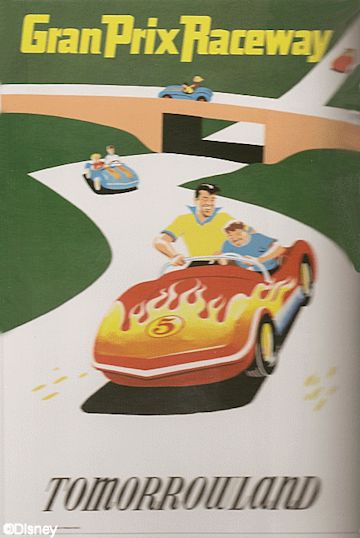
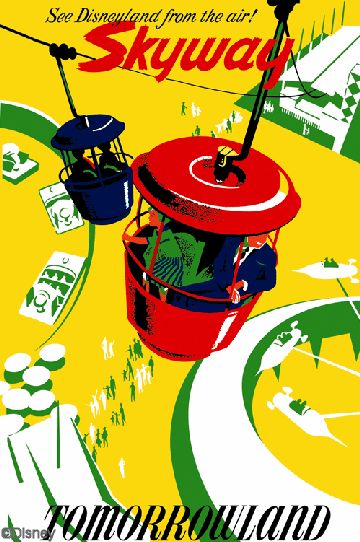
The first Disney Skyway opened at Disneyland on June 23, 1956. Walt was so taken by this mode of transportation that he signed an agreement to purchase this attraction from the Von Roll, Ltd. Company without giving any consideration as to where this ride would be located in his park.
Walt thought of the Skyway as more than just a ride. He thought of it as another mode of transportation that could be used to carry people across large parking lots and shopping centers. He wanted to use Disneyland to showcase this idea.
There is a legend that says that part of Walt’s inspiration for Disney World came to him while riding the Disneyland Skyway. From the lofty height of sixty feet, he could see outside the park and onto the rush-hour traffic of the Santa Ana Freeway that skirted his property. He knew then that he needed more land so he could shield any future project from the outside world.
There were three Disney Skyways in total, the second opening at the Magic Kingdom on October 1, 1971 (opening day) and the third at Tokyo Disneyland on April 15, 1983 (also on opening day). All three offered one-way rides between Fantasyland and Tomorrowland. The Magic Kingdom’s version had the distinction of being the only one that made a turn in the middle of the journey.
It is often reported, incorrectly, that the Magic Kingdom closed the Skyway due to the death of a custodial cast member working on the attraction. Although it is true that Raymond Barlow was accidentally killed while cleaning a narrow Skyway platform, this had nothing to do with the decision to shutter the ride. Disneyland and Tokyo Disneyland had both closed their versions of this attraction before this death occurred. The decision to close all of the Skyways was strictly economical. These attractions were old and expensive to run and maintain. Also, they had low capacities. This made it harder and harder to justify on a “dollar spent per guest ride” basis. Combine this with the constant problem of teenagers spitting and throwing things on the guests below and it’s not hard to understand why Disney said “Enough.” The Magic Kingdom Skyway closed on November 9, 1999.
The Skyway was a perennial favorite of many people. Even though the line was often long, it was worth the wait once we were airborne and looking down on the many sights below. As you passed other gondolas, you would smile and wave to its passengers. And when you could see the terminus station come into view, you grew sad because you knew your flight was almost over.
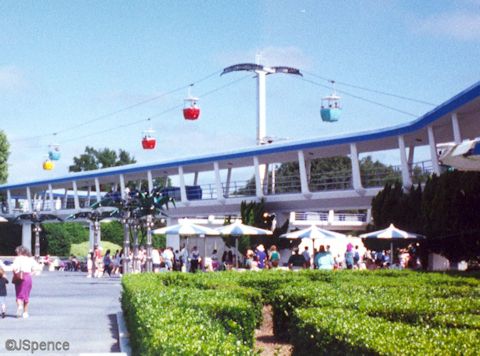
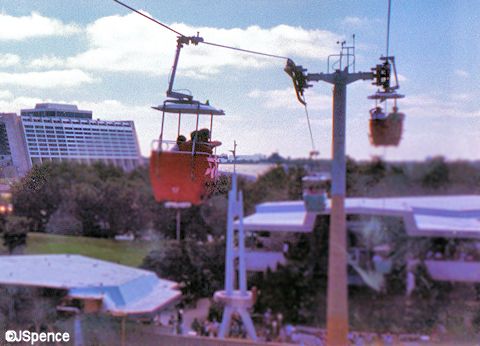
Although the overall concept for Tomorrowland was pretty much set in concrete from the beginning, it wasn’t until sometime in early 1973 that the plans were finalized and this land began to see real growth. For the next two years, construction was an ongoing presence here.
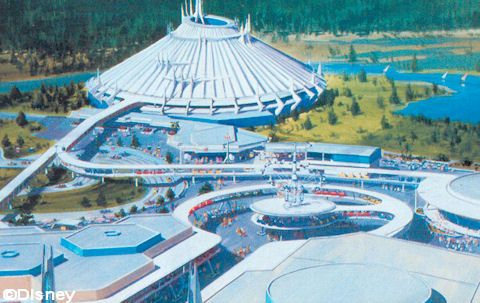
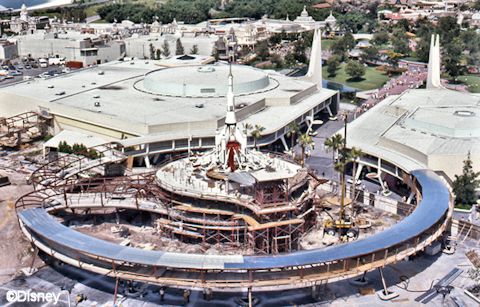
Walt believed in weenies. A weenie (hotdog) was the “item of interest” that would entice a crowd to move in a certain direction. For example, Cinderella’s Golden Carousel was purposely placed directly behind Cinderella Castle to help draw guests into Fantasyland. And the Liberty Square Riverboat Landing was placed directly in line with this land’s entrance to help lure people in. Interestingly, Adventureland intentionally did not have a weenie. It was omitted to help make this exotic land more mysterious.
Keeping the weenie concept in mind, the Imagineers knew Tomorrowland would also need something interesting to draw guests into this land of the future — and the Star Jets filled this bill perfectly. Between this attraction’s soaring height and spinning movement, it was precisely what was required to draw guests down the Tomorrowland concourse.
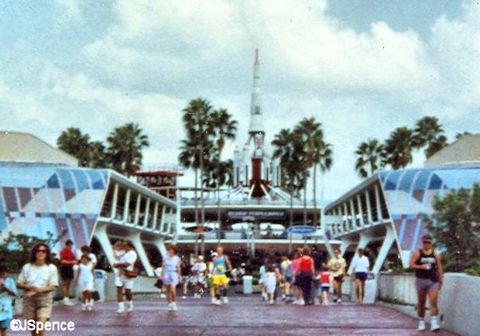
But before we discuss the Magic Kingdom’s Star Jets, let’s take a look at this attraction’s predecessors at Disneyland.
The first space-aged aerial carousel-style ride at Disneyland were the Astro Jets. They officially opened on March 24, 1956. These puppies climbed to the staggering height of 36 feet and traveled in a circle with a 50 foot diameter.
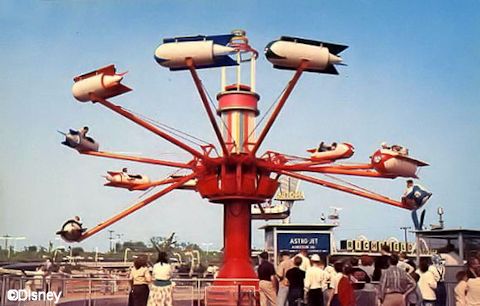
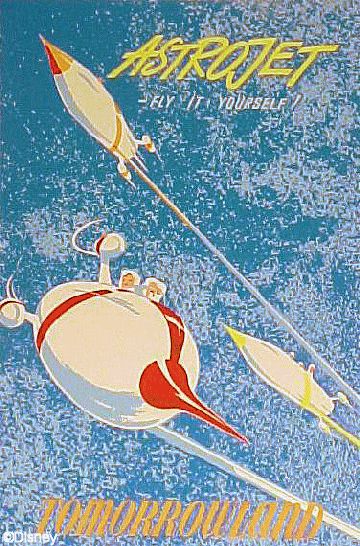
Because money was short and Imagineers were busy working on other projects, Walt decided to buy an off-the-shelf carnival ride and have his people spruce it up later. This task fell to Imagineer John Hench. Besides giving the attraction its now familiar red and white checkered pattern, he also decided that each rocket be given a name. These were, Altair, Antares, Arcturus, Canopus, Capella, Castor, Pica, Procyon, Regulus, Rigel, Sirius, Spica, and Vega.
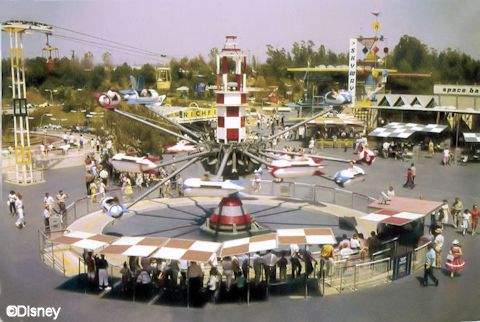
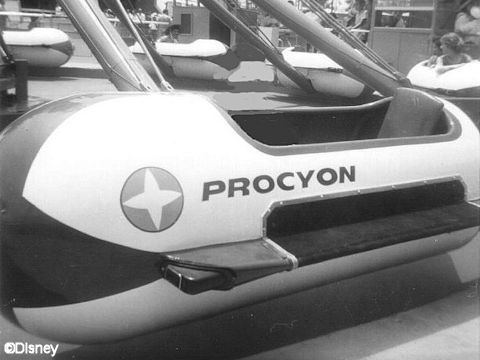
If you counted, you found thirteen names. Although no official reason was given as to why there was one more name than needed, Disney historians speculate that the thirteenth name was a “spare” that could be used if one of the rockets needed to be removed and repaired. Those that pay close attention to such things have never found the name “Pica” on an Astro Jet photograph.
When United Airlines began sponsoring The Enchanted Tiki Room, they complained that the name Astro Jets was giving free advertisement to their competitor, American Airlines who offered coast-to-coast Astrojet service to their customers. In order to keep United happy, the attraction’s name was changed to Tomorrowland Jets. This designation lasted until September 1966 when the ride was closed to make room for the new and improved Tomorrowland.
The attraction returned to Disneyland on July 2, 1967 with an all-new look. Now called Rocket Jets, this new design in theme park space flight now sat atop the Goodyear PeopleMover and was serviced by two gantry-style elevators. The center pylon no longer had a carnival look, but was instead a stylized replica of a Saturn V rocket. And the ride vehicles were sleek and modern. Rocket Jets remained open until 1997 when they were removed to make ready for another Tomorrowland makeover.
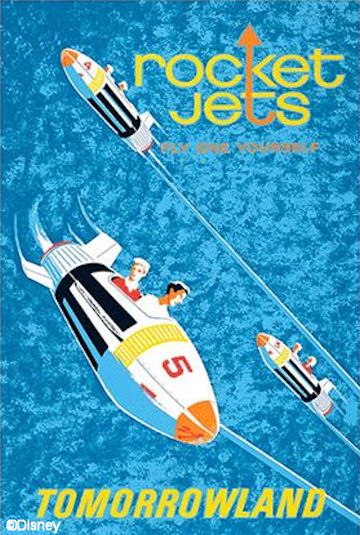
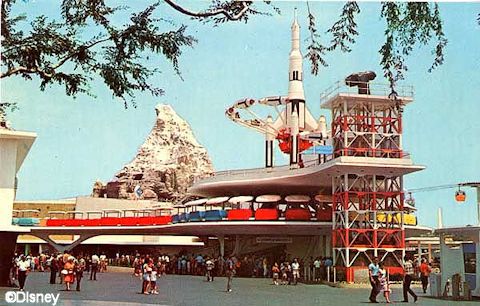
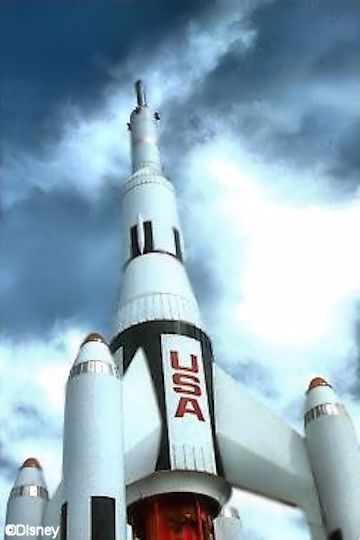
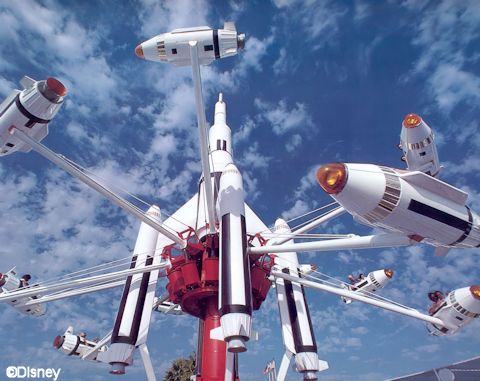
Original makeover plans called for this attraction to once again sit atop the PeopleMover, now Rocket Rods Station, but the new design proved too heavy for the structure. The new Astro Orbitor would end up sitting at ground level near the entrance to Tomorrowland.
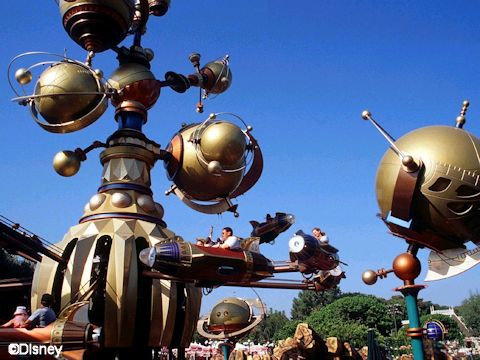
Okay, now let’s get back to the Magic Kingdom of the early 1970’s.
As I mentioned before, the Star Jets would be the weenie that drew people into Tomorrowland. But this attraction was just one part of a “triple whammy.” Copying Disneyland’s successful design, the Imagineers placed a quick-service food stand, the Space Bar, at ground level. The PeopleMover station would sit above the Space Bar. And perched on top of it all would be the Star Jets. This multi-layer designed was created for Disneyland because of space constraints, but it worked so well and fitted the Tomorrowland concept so perfectly, it was repeated in the Magic Kingdom. The Star Jets opened on November 28, 1974.
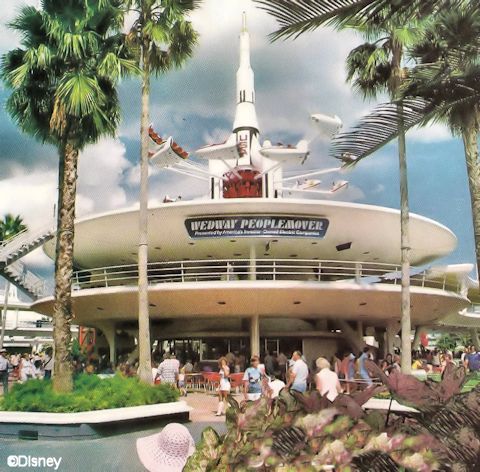
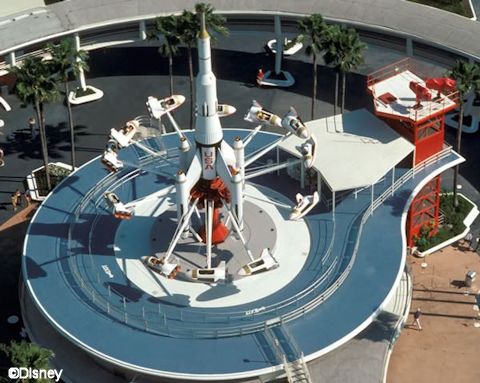
Like Disneyland, the Star Jets center pylon resembled a Saturn V rocket. However, the ride vehicles had a completely different design. At Disneyland, guests rode in mini-rockets. But at the Magic Kingdom, guests were seated in a vehicle that more resembled a hovercraft which featured a broader and flatter design, not to mention the sporty back fins.
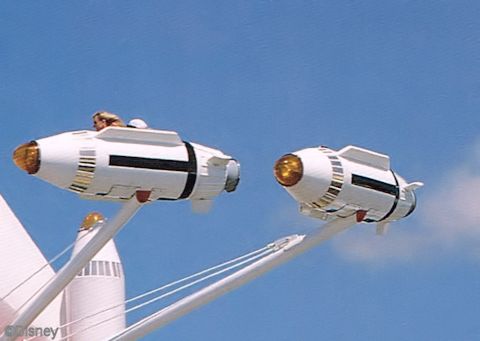
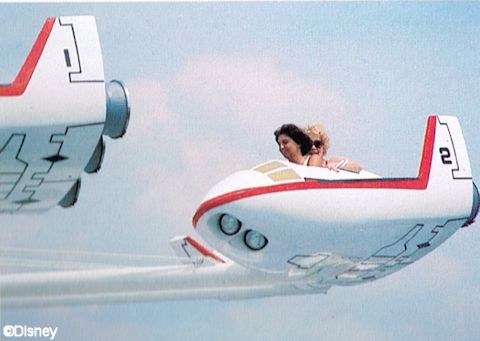
The Star Jets were suspended approximately 80 feet above the ground and were attached to the center pylon by a 20 foot arm. Each of the 12 vehicles held two passengers with up and down flight controlled by a control stick located near the front of the craft. Riders were treated to 11 rotations per minute and the attraction averaged 1.2 million miles a year. Star Jets required a “D” ticket to ride.
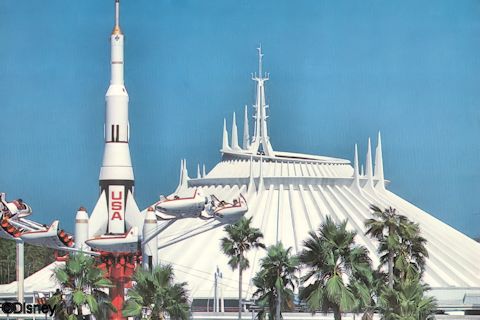

Sitting directly below Star Jets was the WEDWay PeopleMover. Just like I did with the Star Jets, I need to go back in history and take a look at Disneyland’s PeopleMover before discussing the Magic Kingdom’s version.
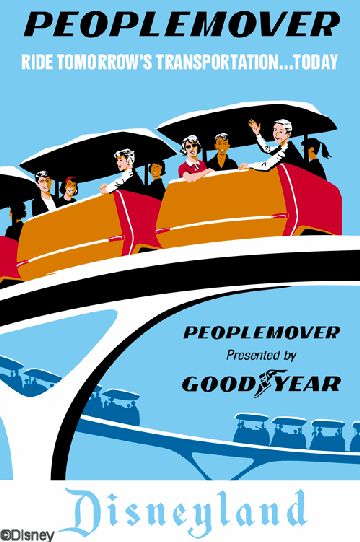
The Disneyland PeopleMover was part of the 1966/67 Tomorrowland makeover. It opened on July 2, 1967. Sponsored by Goodyear, this elevated highway gave guests an overhead preview of all the wonderful adventures that were just waiting to be experienced in the new and old Tomorrowland.
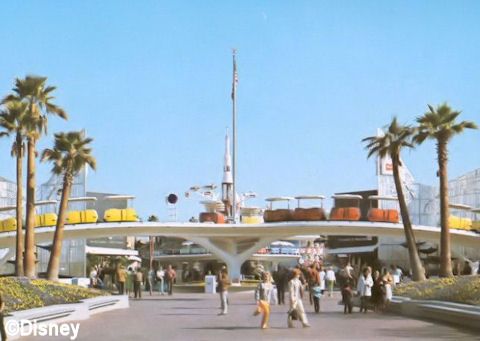
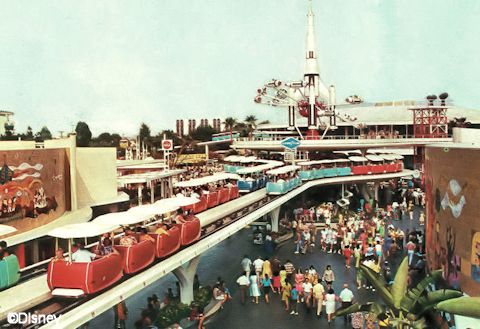
In its day, the PeopleMover was innovative and Walt thought of it as more than just a ride. He felt that the PeopleMover, along with the monorail, could help cities solve problems of congestion and overcrowding. In fact, he was so taken with both of these modes of transportation that they were incorporated into the plans for his future city of EPCOT. In this 1967 concept drawing of EPCOT, you can see both the PeopleMover (left) and the monorail (right).
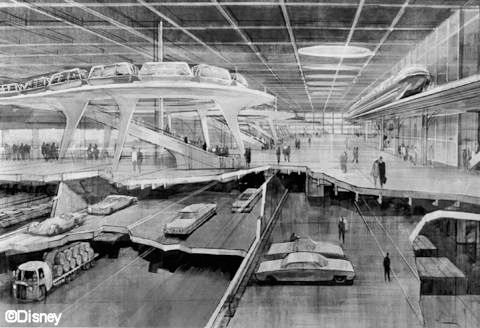
The queuing process for Disneyland’s PeopleMover was unique and innovative. First, guests boarded a speed-ramp (an inclined conveyor belt) for transport to a second level boarding area. At the end of the ramp they were deposited onto a stationary platform, surrounded by a large rotating turntable. Since the inside of a disk moves slower than the outside, it allowed guests an easy transition from the stationary platform to the moving turntable. As they walked to the outer edges of the turntable, their speed gradually increased. This arrangement allowed for better guest safety and improved ride capacity since the cars didn’t need to slow down as much in order to be boarded.
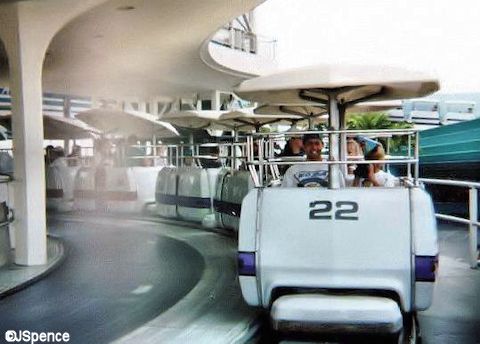
The PeopleMover was powered by small rubber tires (made by Goodyear) embedded along the track. Spaced about every nine feet, hundreds of electric motors powered these tiny tires as they pressed against fiberglass epoxy plates positioned on the bottom of the cars. Top speed: six miles per hour. Each train consisted of four cars, holding four passengers each. They were equipped with power doors and an automated roof that tilted out of the way for easier loading and unloading (see above picture). The PeopleMover had an astonishing capacity of 4,600 guests an hour.
Along the nearly one mile route, a cheery narrative was piped into each car, describing the sights along the way while occasionally praising Goodyear. Unlike its future Florida cousin, Disneyland’s PeopleMover changed elevation as it circled Tomorrowland. It traveled over the Autopia, through shops, and above the submarine lagoon. It even paralleled the monorail for a short distance.
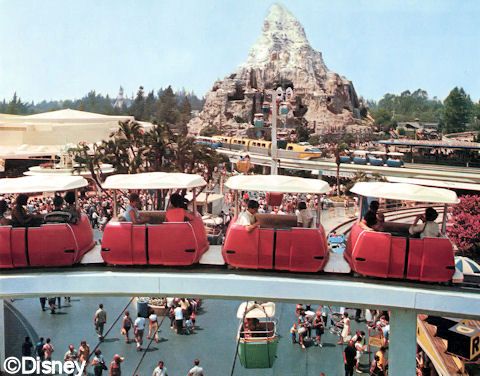
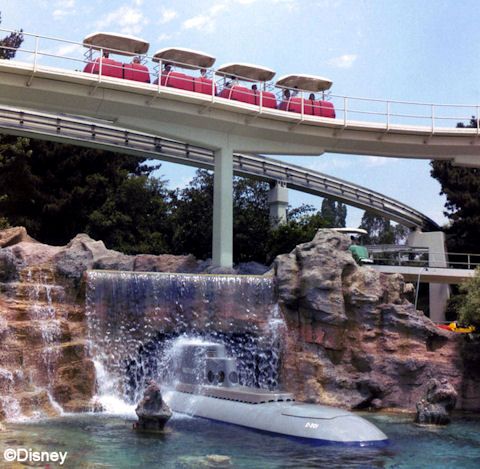
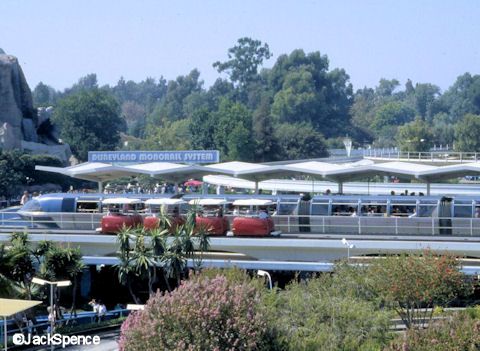
Now back to the Magic Kingdom.
The WEDWay PeopleMover did not open in Tomorrowland until July 1, 1975, almost four years after the Magic Kingdom had opened. However, it was always intended to be included in this land as can be seen in the picture below taken in January 1972. Even though Tomorrowland is far from complete, the PeopleMover right-of-way is clearly visible on the left and right sides of the picture.
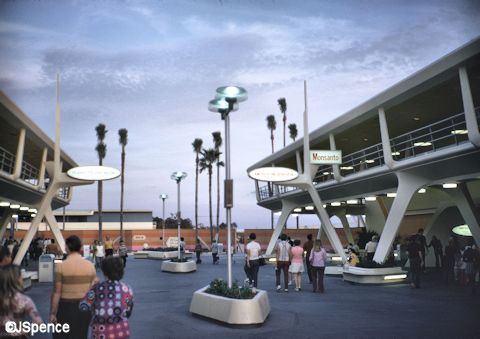
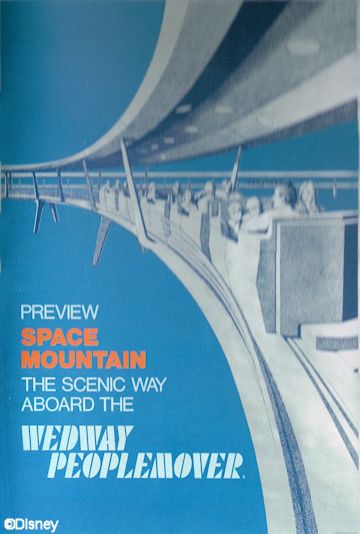
There were several changes made to the Florida version of this ride from its California counterpart. First, it would not be powered by moving wheels embedded in the track, but rather by linear induction motors. This made for a much smoother ride than at Disneyland. It also allowed for better operation during rainy weather. Second, due to Florida’s weather, it was decided that individual roofs over each car would not be sufficient protection from the elements, so the entire track was covered. Another change would be the addition of a fifth car to each train. And as I mentioned earlier, the Magic Kingdom’s version traveled at the same elevation throughout its entire journey.
Another change would come with the attraction’s name, it would now be called the WEDWay PeopleMover. WED are Walt’s initials (Walter Elias Disney). WED Enterprises, or more commonly called “WED,” was the creative branch of the Disney Company. This was where all of the Imagineers worked (and played). Eventually, WED was renamed Walt Disney Imagineering (also known as WDI or simply Imagineering).
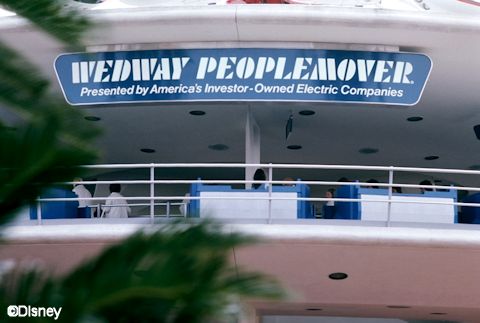
The original sponsor of the WEDWay PeopleMover was the Edison Electric Institute. This association represents all investor-owned electric companies in the United States. Its members provide electricity for 220 million Americans, operates in 49 states and the District of Columbia, and directly employs more than 500,000 workers today.
Back at Disneyland, the Carousel of Progress was being dismantled so it could be shipped to Florida. On the second floor of the COP building was a large model of Progress City – the prototype for the city of EPCOT. The Imagineers didn’t want to destroy this beautiful work of art, yet they had no place to store or display it at Disneyland. It was eventually decided to make it one of the sights seen while riding the new WEDWay PeopleMover in Florida; however, it was much too large in its current state and would need to be cut down dramatically in order to fit into the space available. Believe me, anyone who saw the original model at Disneyland, knows that this resized version pales by comparison.
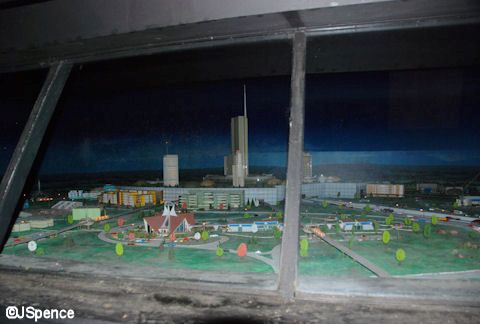

Like Disneyland, The WEDWay PeopleMover gave guests a preview of many of the shops and attractions found in Tomorrowland. Along the way, Jack Wagner (the “Voice of Disneyland”) provided an ongoing commentary. In June 1985, his narration was replaced by the voice of ORAC One – “The Commuter Computer”.
At Disneyland, the PeopleMover just skirted the inside edge of Space Mountain, offering very little to see due to the dark nature of this ride. At the Magic Kingdom, things would be quite different. The WEDWay PeopleMover traveled through the middle of the attraction, giving passengers a fantastic view of astronauts repairing a giant spacecraft.

The WEDWay PeopleMover traveled just shy of a mile in 10 minutes time at a speed of 6.84 mph. It required a “D” ticket to ride.
That’s it for Part Three. Check back next week when I’ll be discussing the Carousel of Progress.



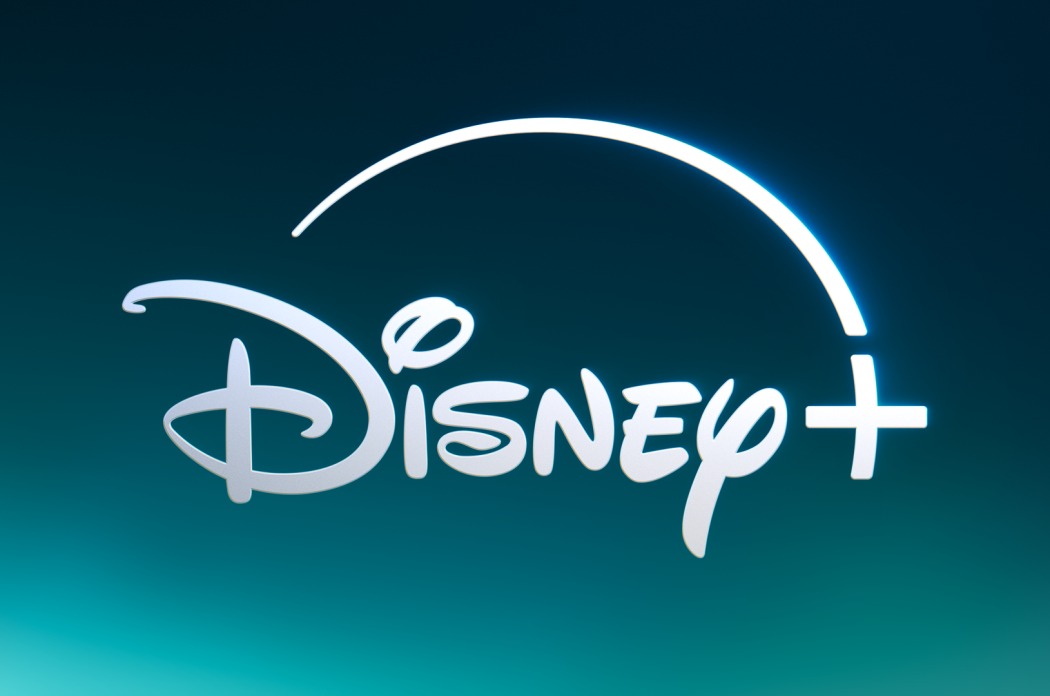
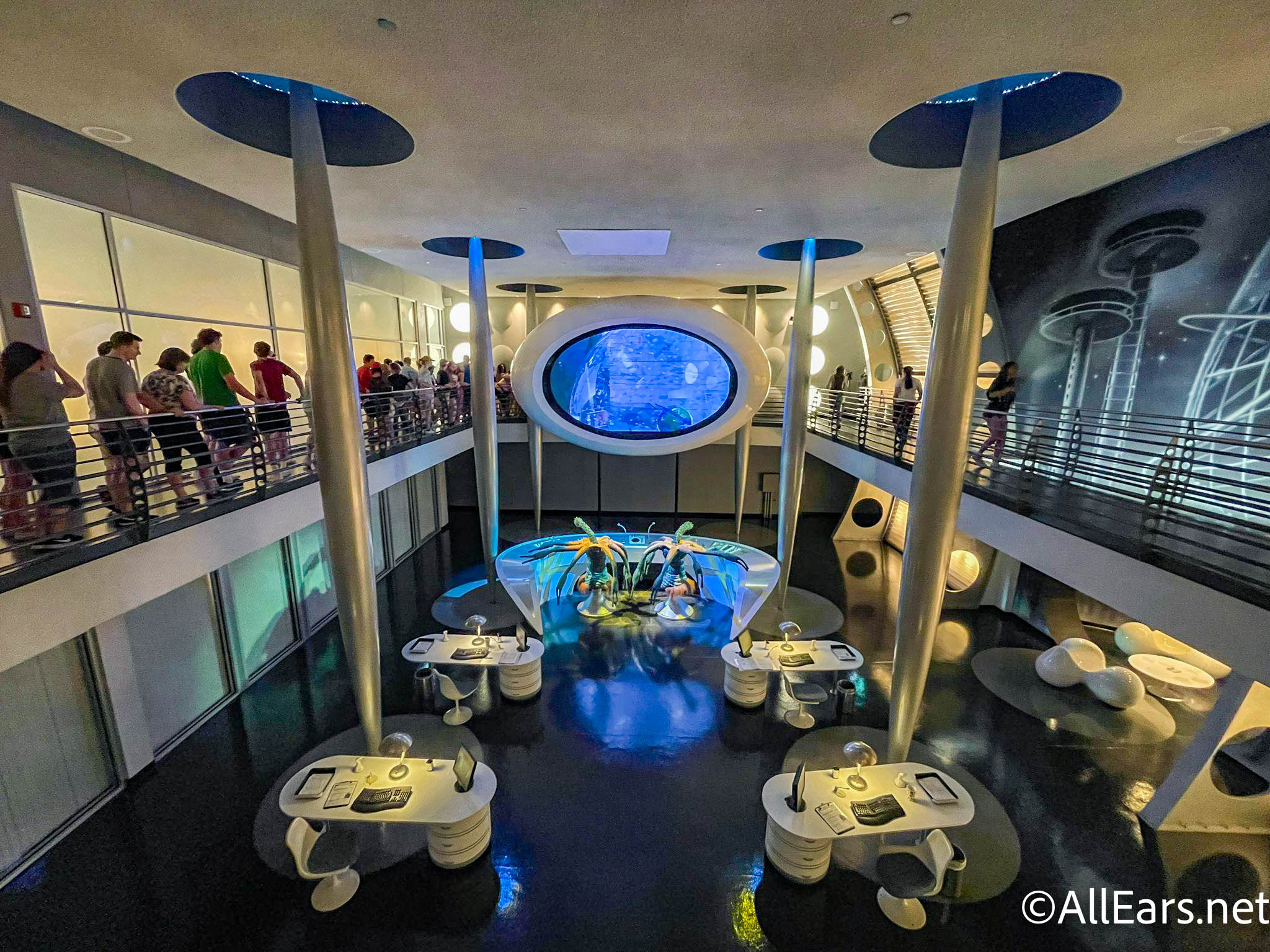
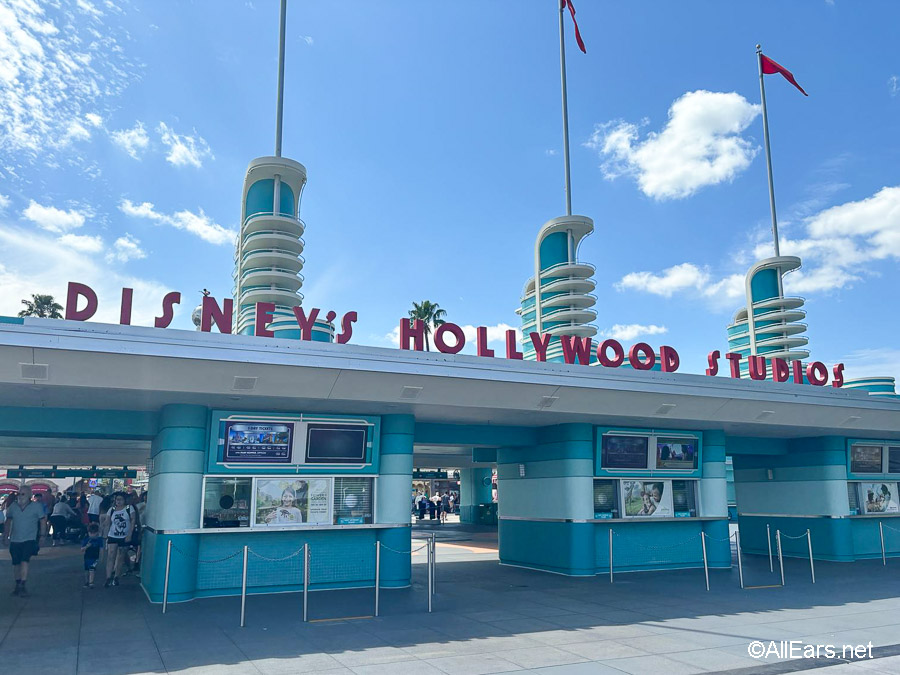
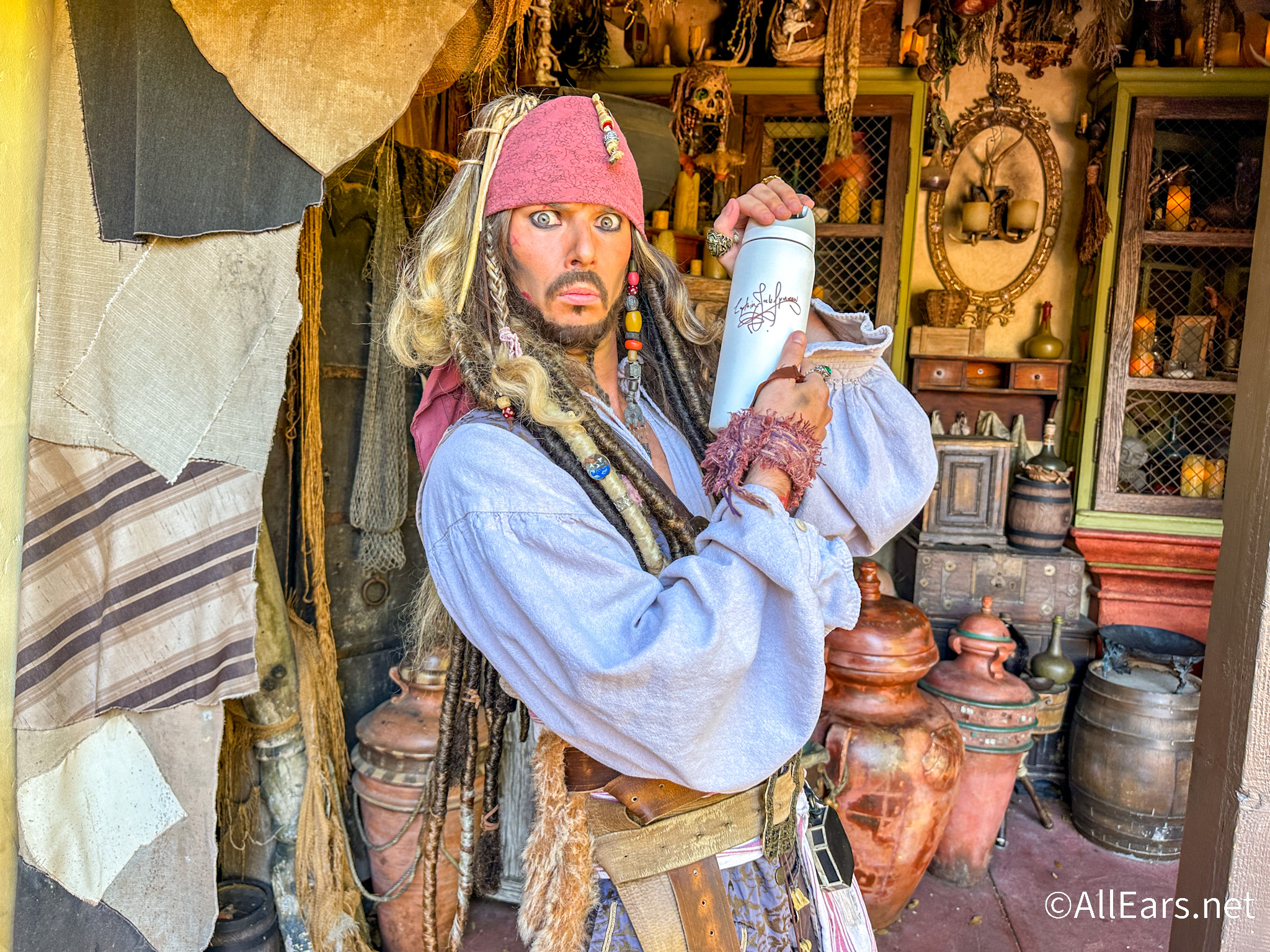

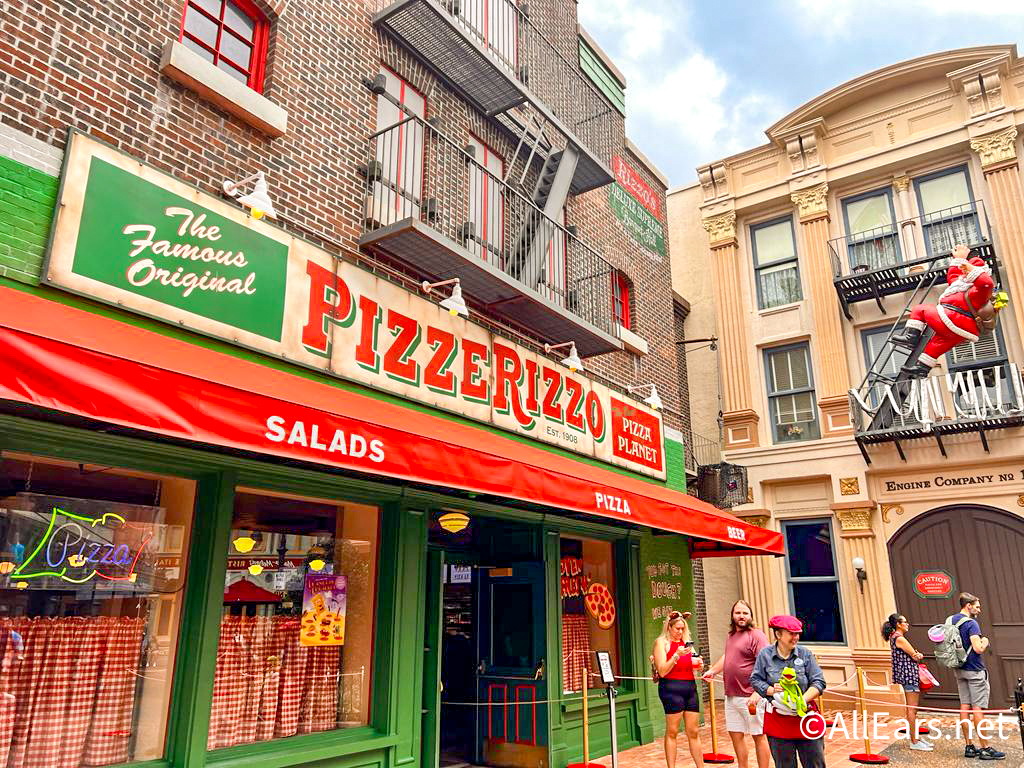
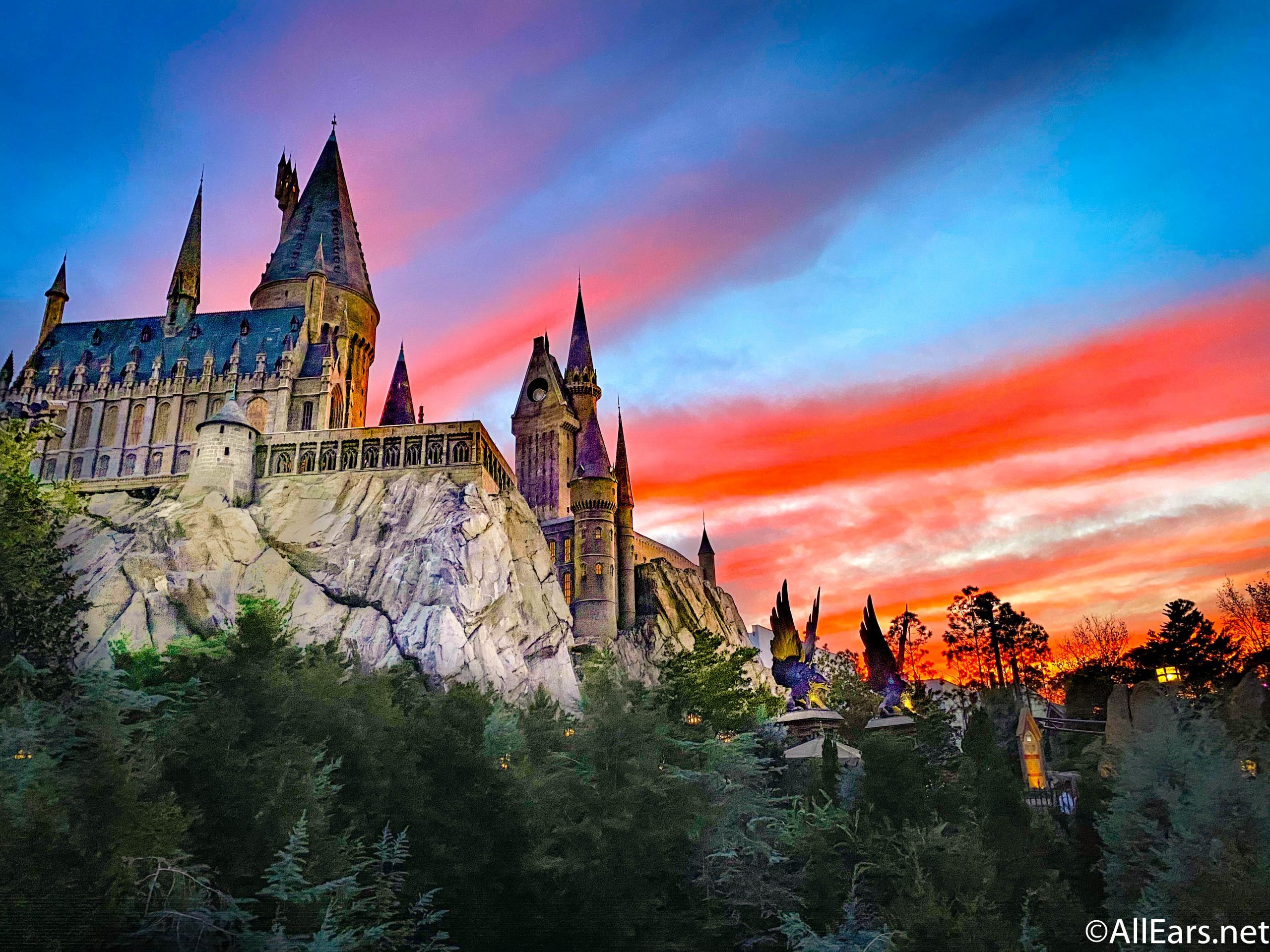


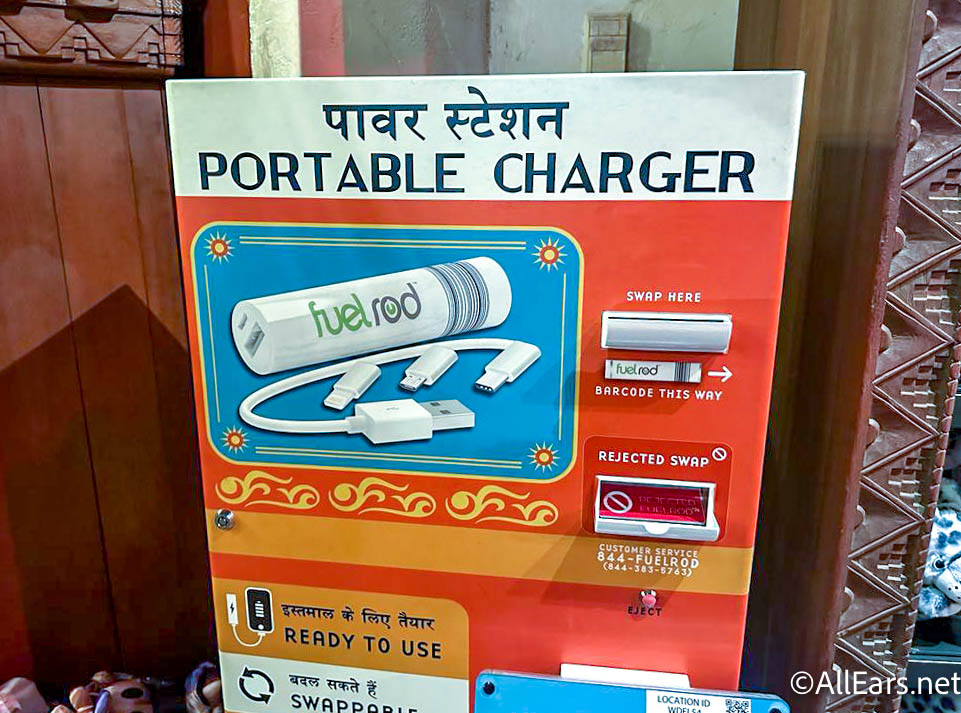
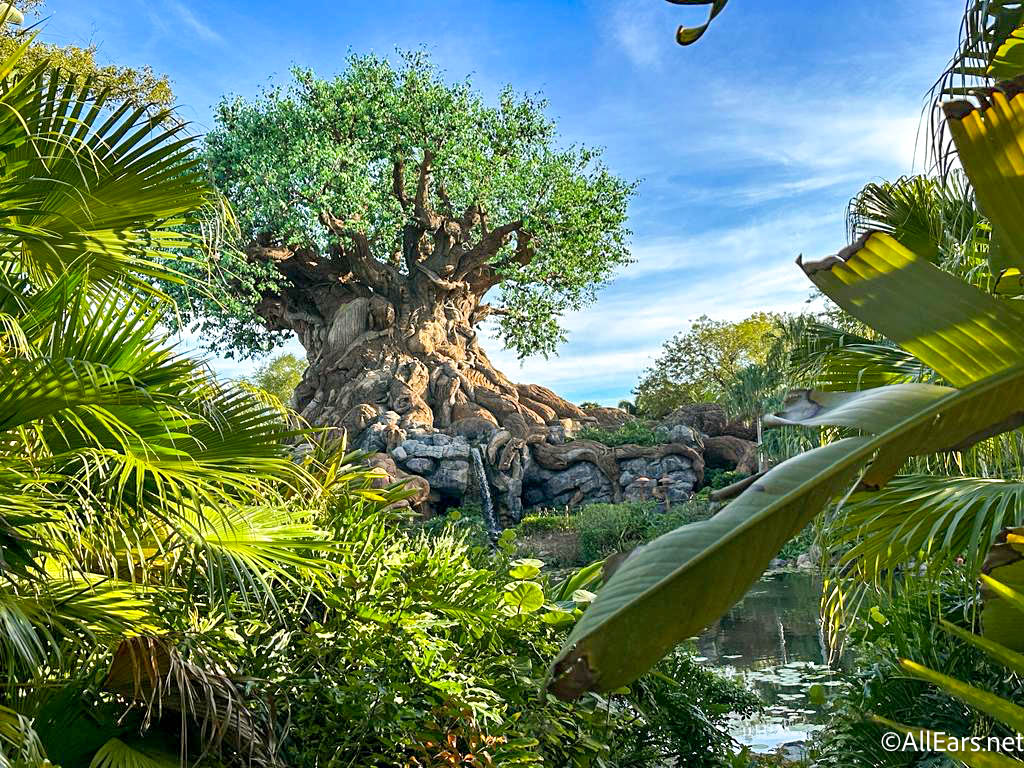
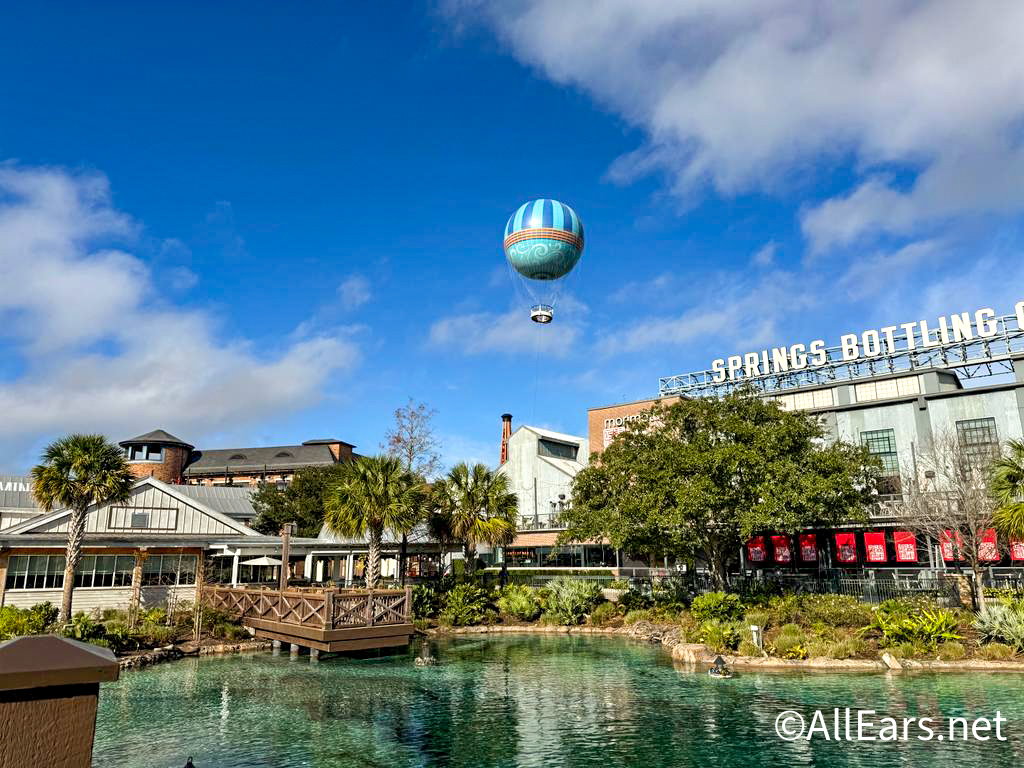
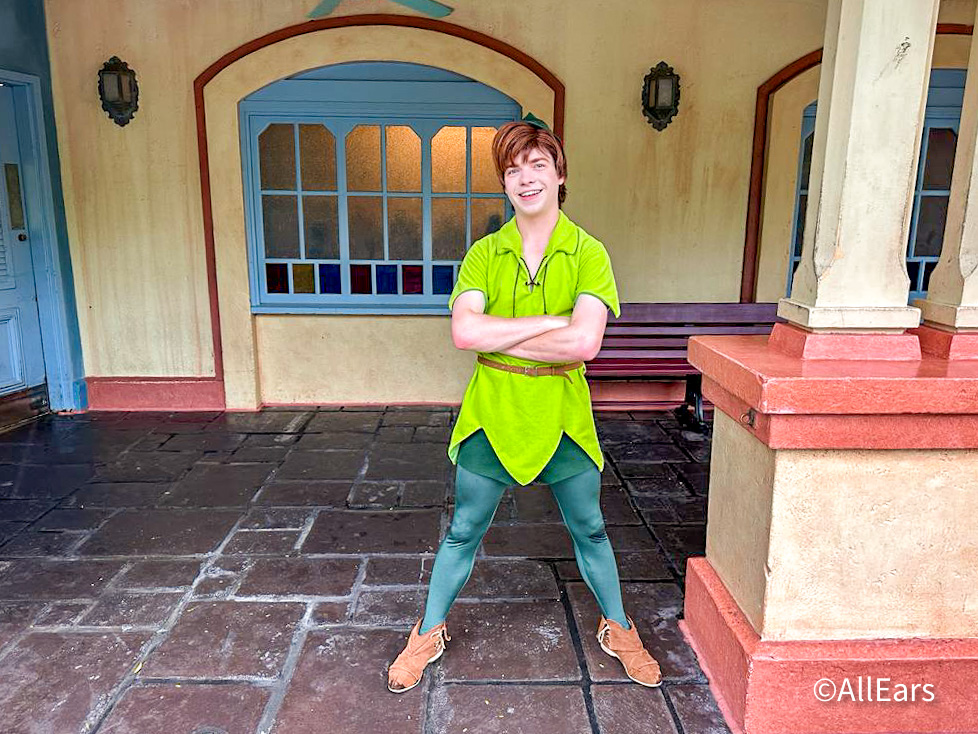
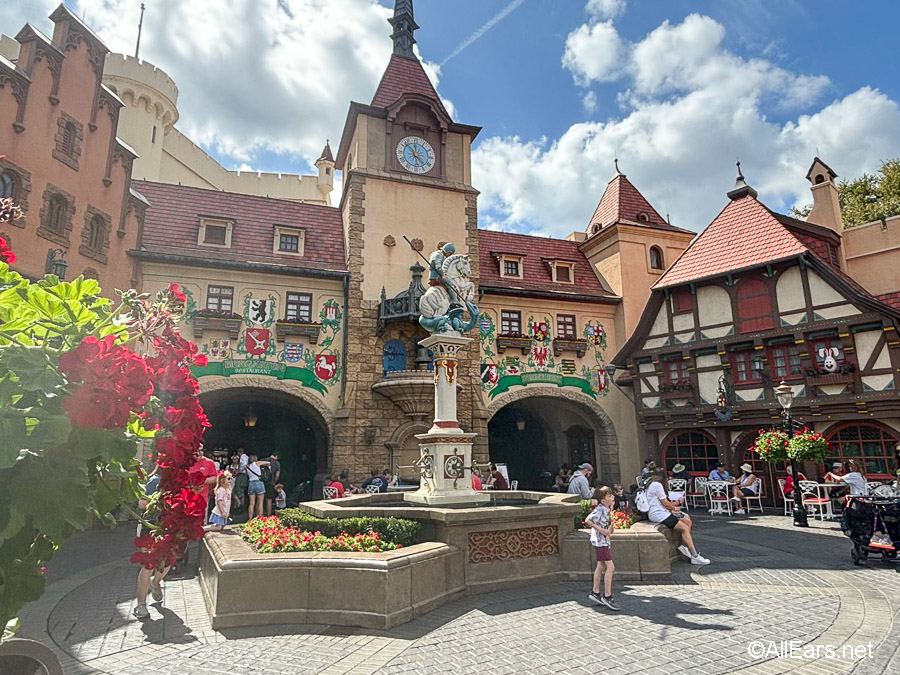
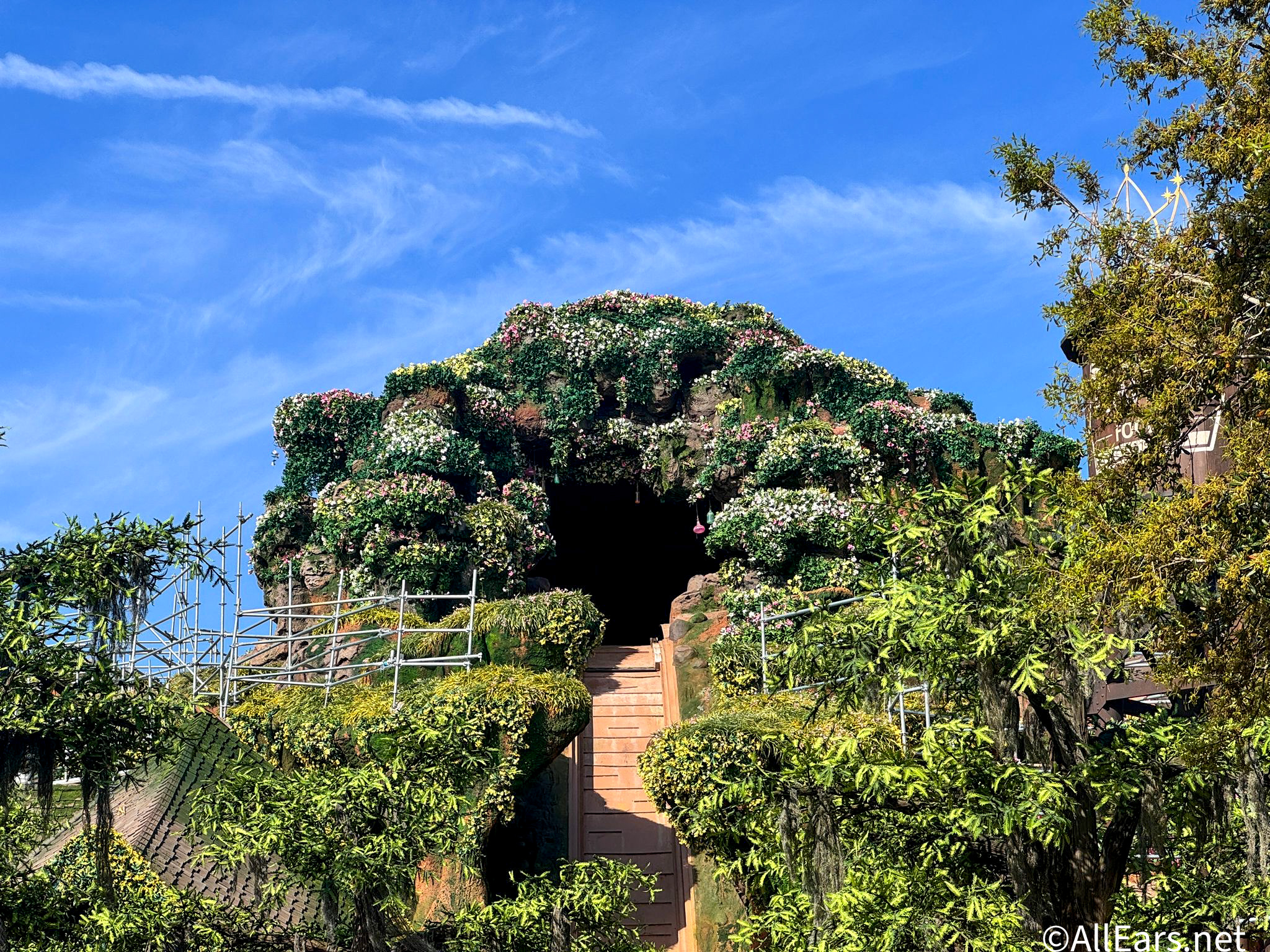

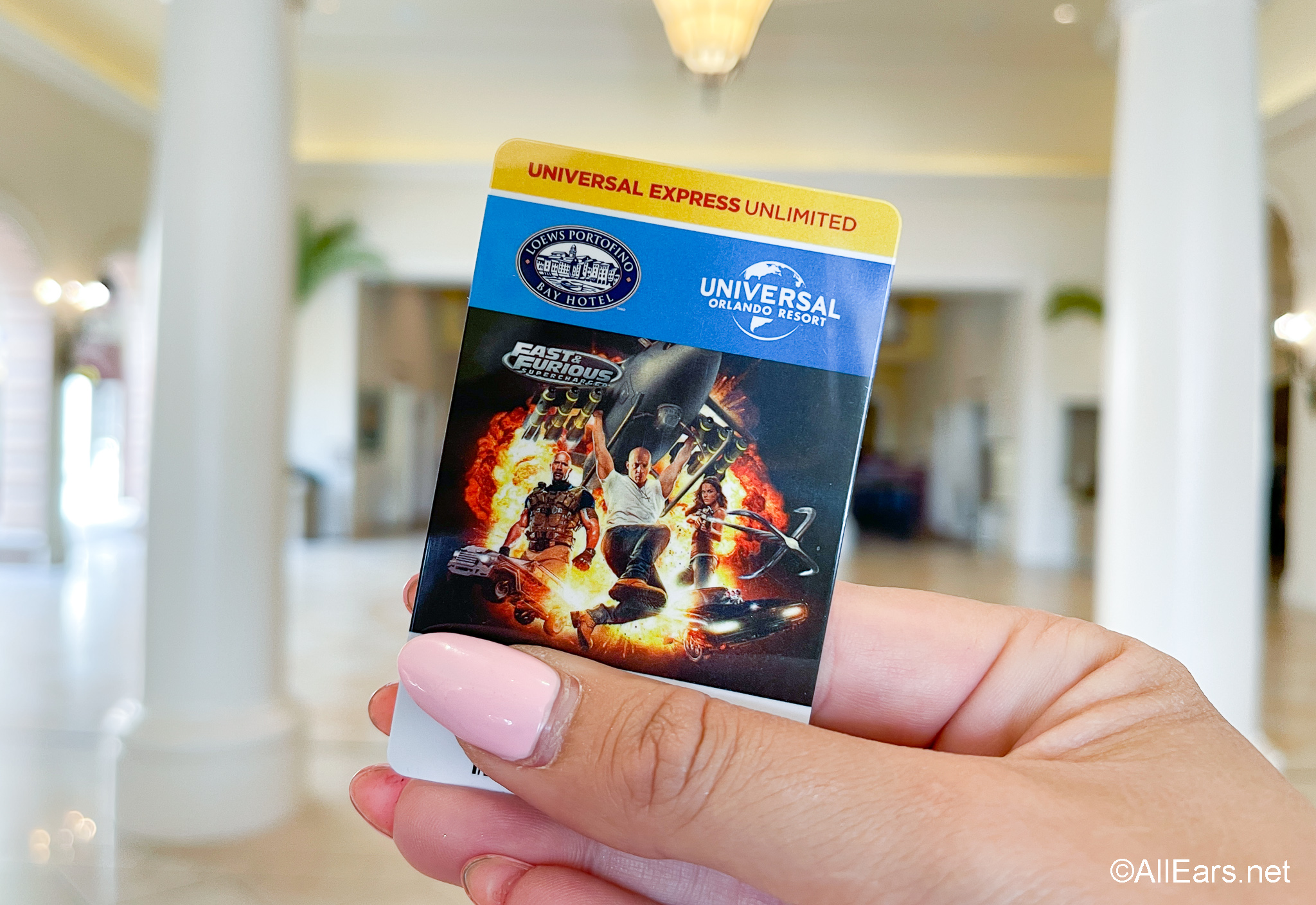
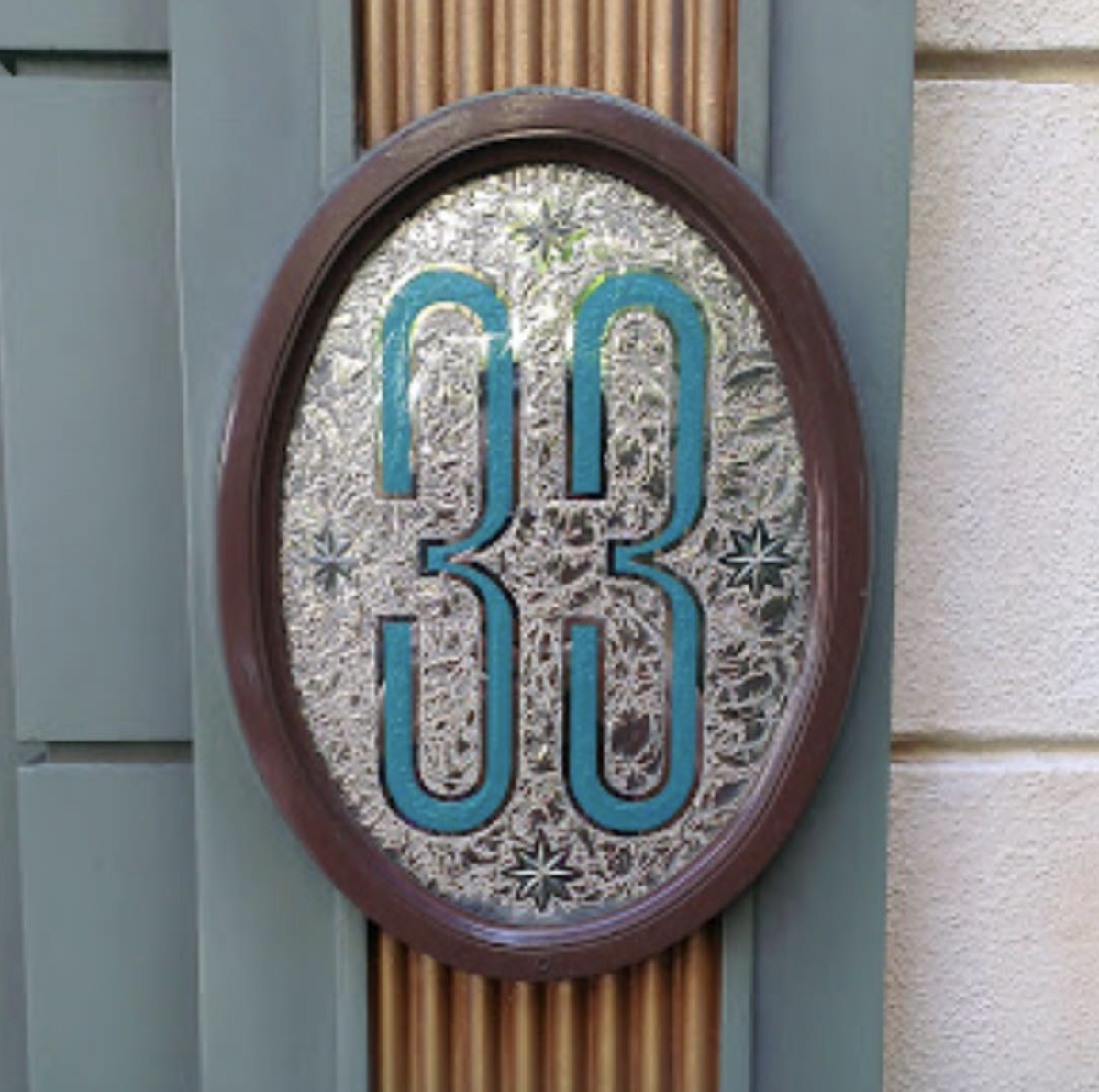

Hi Jack!
Great article, as always!
I just was reading the attractions on a D ticket and noticed that the Admiral Joe Fowler and General Richard Irvine were included in Liberty Square. Are these the same boats that now ferry guests across Seven Seas Lagoon? If so, how did that happen/what’s the history there? Sorry if you’ve covered it before, it just struck me as interesting, I never knew that before.
Thanks!
Jack’s Answer:
When the Magic Kingdom first opened, the Liberty Square Riverboat was named Joe Fowler. A few years later, a second boat was built and named Richard Irvine. During a rehab, one of the boats was being lifted out of the water with a crane and the hull cracked in half. (I don’t remember which one.) Soon after, the remaining boat was renamed Liberty Belle.
The ferries that cross Seven Seas Lagoon were named Kingdom Queen 1, 2, and 3. These were renamed Joe Fowler, Richard Irvine, and Joe Potter. These three men were all instrumental in building Walt Disney World.
Have thoroughly enjoyed this series. We were diappointed then Disneyland tried to change the Peoplemover into a faster moving track ride. I dont think it ever opened and the modified track still sits idle. Any info on what that ride was supposed to be?
Jack’s Answer:
The attraction at Disneyland was called Rocket Rods. It was open sporadically for about a year and a half. I count myself as lucky that I was able to ride it a couple of times.
This attraction uses the same technology as Test Track, which was plagued with problems. If you remember, the opening of Test Track was delayed for well over a year until the Imagineers could get the bugs out. In this case, they were forced to fix the problem because GM was sponsoring Test Track. At Disneyland, no one was sponsoring Rocket Rods and eventually, the Imagineers gave up on it.
I agree with you. Disneyland’s Tomorrowland looks awful with that unused track running through the land.
Jack, I may be wrong on this but seems I recall riding a motorized boat on a track at Disneyland and around the pillars of the Monorail track in Tomorrowland. I think it was around the 1970’s at the time.
Jack’s Comment:
I’m not home so I can’t look up the actual dates, but you are correct. I think
the name of the attraction was Motor Boat Cruise. Actually, it was a pretty
pathetic ride. Even young children were disappointed that they could actually
steer the boats. I rode it several times.
Jack,
I love love love the WEDway People mover. I so wish this technology would have caught on in the “real world” and with linear induction motors I am sure it is quite efficient!! Like someone else above mentioned would have been nice to see a Peoplemover snake its way like a figure eight around Futureworld and World Showcase at EPCOT.
On another note I am partial to the 1970’s Magic Kindom Star Jets cars. Whats really amazing is to compaire them with the the new Space shuttle in development by the Siera Nevada Corp called the Dream Chaser – http://www.sncspace.com/ss_space_exploration.php
See any similarities 🙂 Good to see Disney wasn’t to far from the mark. Lol. Thanks again for another awesome installment.
Dear Jack,
Thanks for another informative blog. One of my favorite Disney memories is of the TTA, years ago when my 15yr old son was a toddler he fell asleep while we were on the ride. The cast member whose was job it was to help everyone exit noticed that he was sleeping and let us stay on the ride. It was a wonderful, relaxing treat for us. It is still one of my favorite rides in the Magic Kingdom.
Just adore this series, Jack! I don’t mind you posting just once a week. Monday is “Jack Day”, I always forget to check mid-week whenever you do the semi-weekly postings so I don’t mind waiting until the next Monday to hear more. Besides, we don’t want you to get burned out and quit writing altogether!
People Mover is always a great choice but I can’t wait until next week to hear about my favorite of all, the Carousel of Progress!
Jack,
I just got around to watching the PeopleMover video, and it reminded me of something that has always intrigued me.
The narration that we hear comes from overhead speakers vs. speakers attached to the ride vehicles (as can be seen around the 2:45 mark and other times in the video). Because the vehicles are constantly moving, I imagine that the speakers play only a small amount of dialogue that is continually repeated.
First, am I correct? Second, if so, I’m curious about how the movement of the vehicles is so well coordinated with the audio. I’ve never experienced a mishap, but I’m sure it’s occurred.
Jack’s Answer:
You are correct. The narrative for the PeopleMover comes from speakers mounted in the overhead canopy. You are also correct that each set of speakers only plays a small portion of the total narrative. If you stand beneath the track between the restrooms and the Carousel of Progress, you can hear the same message repeated over and over.
I assume there are sensors in the track that activate the message as the vehicles move along.
Jack,
Thanks again for a great blog entry. The Peoplemover (will always be TTA to me) is one of my favorite rides at the Magic Kingdom.
I was sad to find on my recent trip that they changed the narration. I really enjoyed the more recent narration because it made it feel more like a ride.
“Welcome aboard, TTA travelers!!!!”
Hi Jack —
Once again, kudos and thanks for a great blog! I’ve only ridden the Astro Orbiter once, in 1998 — another flight has not been scheduled since.
I do miss the Skyway. It was always such a wonderful trip and I always got a kick out of the turn — I wonder if any other cable car anywhere in world (real one, not Disney) has a turn on its route. I was always amazed at the number of Lightning Rods you could see on the roofs of all the park buildings, a feature you could best see from above. Wasn’t there some sort of water feature/water fall on the Tomorrowland Skyway Terminal? I seem to remember one under where the cars entered/exited the building.
By far, one of my all time favorite rides is the People Mover. It’s just such a pleasant way to travel, even if you get off where you get on. I do miss the view of Space Mountain’s queue and the Coaster that you used to see when passing thru Space Mountain, which vanished in 2009. I especially enjoy riding at night when everything is lit up. I have a video posted at http://www.youtube.com/watch?v=iNyf8a_zVZY of a Tomorrowland Transit Authority night ride taken at the end of 2010’s Summer Nightastic promotion where the Wedway was lit with pink colored lights. (PS: you’re camera work is so much better and more professional than mine).
Anyway, looking forward to the next chapter, and I echo Doug’s sentiments in re twice-a-week postings of this series. However, good things come to those who wait and I’ll just have to be patient.
– Jeff
Jack’s Answer:
Yes. There was a waterfall at the Tomorrowland Skyway station. You can see a picture of it in Part One of my Water Series blogs:
http://land.allears.net/blogs/jackspence/2014/04/water_at_walt_disndy_world_par.html
All of the Disney parks are so beautiful when lit up at night. I understand why you shot a PeopleMover video in the evening.
I seriously thought about posting my Tomorrowland series twice a week, but to be honest, this gives me a mini-vacation. I was able to write all eight articles in about two weeks. Now I have six weeks off to casually look for new ideas.
Hi Jack,
The People Mover is one of my very favorite rides. A chance to relax, rest the feet and enjoy a scenic view and a little breeze.
There really should be a People Mover weaving its way all around Epcot with about 4 or 5 stations, so guests could actually use it as a mode of transportation. Think of how nice it would be to go to Morocco for lunch without all that walking or waiting for a boat.
Jack, Here is a little know fact: Disneyland, with the Anaheim Fire Department, used to perform evacuation drills on the Skyway. I’m not sure how often these were done, but I was able to participate once, when I was in the Disneyland Management Training Program (in 1991). Union employees could not be used as evacuees, so management was asked to do it. I was sent up with 3 other people, and we sat for at least an hour while the Fire Department evacuated each car, one at a time. I think we had around 4 cars in total. It was kind of fun, but a little scary when it came time to climb out on to the latter. All of this was done in Fantasyland, not far from Dumbo, and of course, the part was closed.
Great as always Jack!
Anyway, you mentioned that the StarJets at MK look like hovercraft with fins. Search “Lifting Body” especially the X-24. It first flew in 1969 and probably the design inspiration than a hovercraft.
Can’t wait for part four. Too bad you’re not posting this series two times a week. But, if I have to wait another week I will. Your blogs are so informative! I bet you can do a great blog just on the sanitary upkeep of the parks and it would be very interesting.
Hi Jack….
It’s a real shame that Epcot never had a PeopleMover running thru Future World. At MK it is only “representative” of what Walt wanted it to be. At Epcot it could have been a functional “People Mover” in addition to being a ride.
It’s the only time you’ll hear me say “…it’s what Walt would’ve wanted.”
Hey Jack
I do miss the skyway attraction. It was a great way get a different perspective of the park. The people mover is a great attraction and the line is never too long. As for Astro Orbitor, I have never ridden it. The line is always too long. One of these days I will. Can’t wait for your next blog and as always keep up the great work.
I still keep a “first person pov” video of my son and I riding the Star Jets in WDW on my iPhone: 90 seconds of pure fun!
I will be traveling to the World in late July and unfortunately the People Mover will be under construction and closed.
Just a nice relaxing way to sit for 10 minutes and cool down in the summer heat….will be missed this year!
How unfortunate that the original EPCOT model had to be cut back due to the limited space in the PeopleMover ride area. It’s particularly ironic given that Central Florida was chosen as the site for WDW based on the abundance of space available! It would have been nice if another semi-permanent area could have been chosen, with a permanent home somewhere in Epcot itself.
Hi Jack! Let me start by saying I miss the Skyway! Although I only rode it a couple times, it was definitely a fav. Being able to look below and see all the wonderful views of the MK was amazing.
The People Mover will always be my go to ride when my feet hurt (usually, because I make poor shoe choices) :). I find it to be relaxing, a great way to get out of those afternoon rain showers, and a great way to see Space Mountain as a spectator.
Keep up the great work!